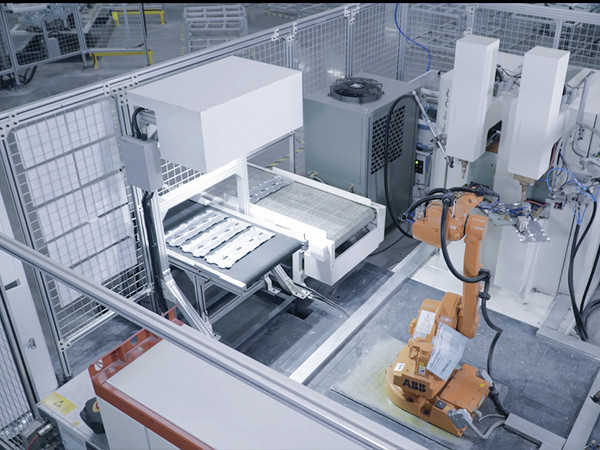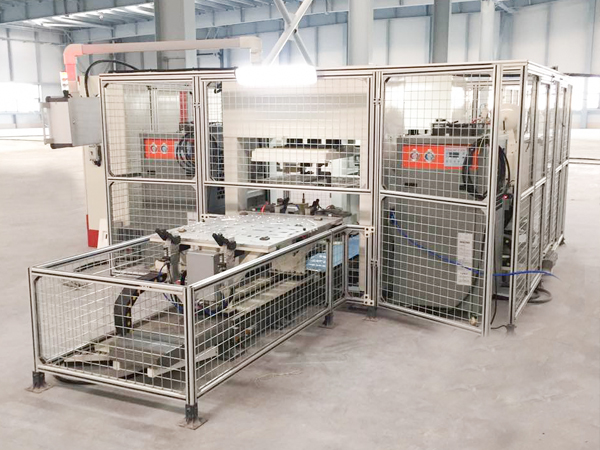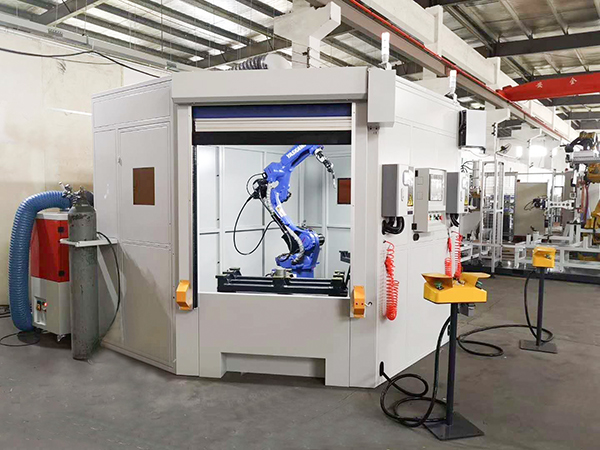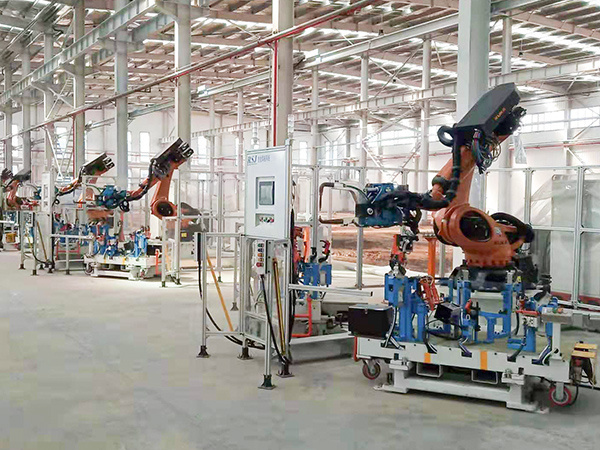点焊机采用双面双点过电流焊接原理,两个电极对神器加压,使两层金属在两个电极的压力下形成某些压力接触电阻,和焊接电流什么时候从一个电极流到另一个电极时,在两个接触电阻点处形成瞬时热焊接,焊接电流立即从另一个电极沿着两个神器流到该电极,形成回路,并且不会损坏电极的内部结构。焊接神器。
中文名
点焊
采用
双面双点过电流焊接原理
形成
某些接触电阻
按
同时焊接的焊点数量
目录
1引言
2工作准则
3机械用途
4安全性
5安装与维护
6 钢筋点焊
介绍
编辑
点焊按照用途分,有万能式(通用式)、专用式;按照同时焊接的焊点数量,有单点式、双点式、多点式;按照导电方式分,有单侧的、双侧的;按照加压机构的传动方式分,有脚踏式、电动机-凸轮式、气压式、液压式、复合式(气液压合式);按照运转的特性分,有非自动化、自动化;按照安装的方法分,有固定式,移动式或轻便式(悬挂式);按照焊机的活动电极(普通是上电极)的移动方向分,有垂直行程(电极作直线运动)、圆弧行程;按照电能的供给方式分,有工频焊机(采用50赫兹交流电源)、脉冲焊机(直流脉冲焊机、储能焊机等)、变频焊机(如低频焊机)。
什么时候神器和电极一定时,神器的电阻取决与它的电阻率.因此,电阻率是被焊材料的重要性能.电阻率高的金属其导电性差(如不锈钢)电阻率低的金属其导电性好(如铝合金)。因此,点焊不锈钢时产热易而散热难,点焊铝合金时产热难而散热易.点焊时,前者可用较小电流(几千安培),和后者就必须用很大电流(几万安培)。电阻率不仅取决与金属种类,还与金属的热处理状态、加工方式及温度有关。
为了保证熔核的大小和焊点的强度,焊接时间和焊接电流可以在一定范围内互补。为了获得一定的焊点强度,可以使用大电流和短时间(强条件,也称为硬代码),或者小电流和长时间(弱条件,也称为软代码)。用过的。硬规格或软规格的选择取决于所用焊接机的性能,厚度和功率。对于不同特性和厚度的金属,电流和时间有上限和下限,使用时应优先使用。
电极压力对两电极间总电阻R有明显的影响,随着电极压力的增大,R显著减小,和焊接电流增大的幅度却不大,不能影响因R减小引起的产热减少。因此,焊点强度总随着焊接压力增大而减小。解决的办法是在增大焊接压力的同时,增大焊接电流。
分类
点焊按用途可以分成万能式(通用式、专用式)点焊;
按同时焊接的焊点数量为:有单点式、双点式、多点式;
根据导电方式,分为单面和双面;
根据增压机构的传动方式,分为:脚踏板,马达凸轮型,气动型,液压型,复合型(气动液压型);
根据操作特点:非自动化和自动化;
按安装的方法分为:固定式,移动式或轻便式(悬挂式)点焊;
根据焊接机可移动电极(通常是上部电极)的移动方向,可分为:垂直行程(电极线性移动)和圆形行程。
工作准则
编辑
点焊的工艺过程为开通冷却水;将焊件表面清理干净,装配准确后,送入上、下电极之间,施加压力,使其接触良好;通电使两神器接触表面受热,局部熔化,形成熔核;断电后保持压力,使熔核在压力下冷却凝固 形成焊点;去除压力,取出神器。焊接电流、电极压力、通电时间及电极工作表面尺寸等点焊工艺参数对焊接质量有重大影响。
点焊利用正负两极在瞬间短路时产生的高温电弧来熔化电极间的被焊材料,来达到使它们结合的目的。点焊的结构十分简单,说白了就是一个大功率的变压器,将220V交流电变为低电压,大电流的电源,可以是直流的也可以是交流的。电焊变压器有自身的特点,就是具有电压急剧下降的特性。
电极点火后,电压下降,调节焊接机的工作电压,除了初级220/380电压转换外,次级线圈还具有抽头来改变电压,并且还有一个烙铁铁心调整可调铁心。焊接机通常是使用电感原理制成的大功率变压器。电感在打开和关闭时都会产生巨大的电压变化。在瞬时短路期间,由正极和负极产生的高压电弧用于熔化电极上的焊料。以达到将它们结合起来的目的。
点焊是焊件装配接接头,并压紧在两电极之间,利用电阻热熔化母材金属,形成焊点的电阻焊方法。点焊多 用于薄板的连接,如飞机蒙皮、航空发动机的火烟筒、汽车驾驶室外壳等。点焊焊接变压器是点焊电器,它的次级只有一圈回路。上、下电极与电极臂既用于传导焊接电流,又用于传递动力。冷却水路通过变压器、电极等部分,以免发热焊接时,应先通冷却水,然后接通电源开关。电极的质量直接影响焊接过程、焊接质量和生产率。电极材料常用紫铜、镉青铜、铬青铜等制成;电极的形状多种多样,主要根据焊件形状确定。安装电极时,要注意上、下电极表面保持平行;电极平面要保持清洁,常用砂布或锉刀修整。焊接循环点焊和凸焊的焊接循环由四个基本阶段(点焊过程):
(1)预压阶段——电极下降到电流接通阶段,确保电极压紧神器,使神器间有适什么时候压力。
(2)焊接时间——焊接电流通过神器,产热形成熔核。
(3)维护时间-切断焊接电流,继续保持焊条压力,直到熔核凝固到足够的强度为止。
(4)休息时间-焊条开始上升,焊条再次开始下降,下一个焊接周期开始。
为了提高焊接接头的性能,有时有必要在基本循环中添加以下一项或多项内容:
(1)加大预压力以消除厚神器之间的间隙,使之紧密贴合。
(2)用预热脉冲提高金属的塑性,使神器易于紧密贴合、防止飞溅;凸焊时这样做可以使多个凸点在通电焊接前与平板均匀接触,以保证各点加热的一致。
机械用途
编辑
点焊使用方法:
1.在焊接过程中,应调整电极棒的位置,以便在将电极按在焊件上时,电极臂保持彼此平行。
2.可以根据焊件的厚度和材料选择电流调节开关级。开机后,电源指示灯应亮起。可以通过调节弹簧压力螺母并改变其压缩程度来调节电极压力。
3、在完成上述调整后,可先接通冷却水后再接通电源准备焊接。焊接过程的程序:焊件置于两电极之间,踩下脚踏板,并使上电极与焊件接触并加压,在继续压下脚踏板时,电源触头开关接通,于是变压器开始工作次级回路通电使焊件加热。什么时候焊接一定时间后松开脚踏板时电极上升,借弹簧的拉力先切断电源而后恢复原状,单点焊接过程即告结束。
4.焊件的准备和组装:焊接前必须清除钢焊件上的所有污垢,油污,水垢和铁锈。对于热轧钢,最好首先通过酸洗,喷砂或使用砂轮去除氧化皮来选择焊接区域。尽管可以清洗未清洗的焊件,但会严重降低电极的使用寿命,并且还会降低生产效率和点焊质量。对于薄涂层的中低碳钢,可以直接焊接。
此外,使用时,用户可以参考以下过程数据:
1、焊接时间:在焊接中低碳钢时,本焊机可利用强规范焊接法(瞬时通电)或弱规范焊接法(长时通电)。在大量生产时应采用强规范焊接法,它能提高生产效率,减少电能消耗及减轻神器变形。
2.焊接电流:焊接电流取决于焊件的尺寸,厚度和接触面。通常,金属电导率越高,电极压力越大,焊接时间越短。此时所需的电流密度也增加。
3.电极压力:电极向焊接件施加压力的目的是减少焊接点的接触电阻并确保形成焊接点时所需的压力。
安全
编辑
1.在现场使用时,应有防雨,防潮,防晒棚,并应安装相应的消防设备。
2.在焊接地点的10m范围内,不得堆叠易燃易爆材料,例如油,木材,氧气瓶和乙炔发生器。
3.焊接作业和合作人员必须穿戴要求的劳动保护设备。必须采取安全措施以防止诸如电击,高空坠落和气体中毒之类的事故。
4.连接到次级抽头的铜板应紧固,端子应有垫圈。在关闭之前,应仔细检查接线螺母,螺栓和其他零件,并确保它们完整无缺,没有松动或损坏。端子处有保护盖。
5.使用前,应检查并确认初、次级线接线正确,输入电压符合电焊机的铭牌规定,知道点焊焊接电流的种类和适用范围。接通电源后,严禁接触初级线路的带电部分。初、次级接线处必须装有防护罩。
6.移动点焊时,应切断电源,不得用拖拉电缆的方法移动焊机。什么时候焊接中突然停电时,应立即切断电源。
7.焊接铜,铝,锌,锡,铅等有色金属时,必须在通风良好的地方进行,焊接人员应佩戴防毒面具或呼吸过滤器。
8.多台点焊集中使用时,应分接在三相电源网络上,使三相负载平衡。多台焊机的接地装置,应分别由接地极处引接,不得串联。
9.严禁在运行中的压力管道,装有易燃易爆材料和受压部件的容器上焊接。
10.焊接预热零件时,应设置挡板以将辐射热与预热焊接零件隔离开。
安装及保养
编辑
为了确保人身安全,使用前必须将焊接机正确接地。在使用焊接机之前,请先使用500V兆欧表测试焊接机的高压侧与机壳之间的绝缘电阻不小于2.5兆欧,然后才能通电。在打开包装和检查之前,必须在检查过程中切断电源。焊机首先要通水,然后再进行焊接,严禁无水工作。冷却水应确保在5--30°C的入口压力为0.15-0.2MPa的情况下供应工业用水。冬季焊接机完工后,使用压缩空气吹送管道中的水,以避免水管冻结和破裂。
焊接机的导线不应太细或太长,焊接时的电压降不得大于初始电压的5%,初始电压不得偏离电源电压的±10%。在操作焊接机时,应戴上手套,围裙和防护眼镜,以免火花飞溅出火花。滑动部件应保持良好润滑,使用后应清除金属飞溅物。新焊机使用24小时后,应拧紧各部分的螺钉一次,尤其要注意铜质挠性接头与电极之间的连接螺钉。使用后,应经常清除电极棒和电极臂之间的氧化,以确保良好的接触。
使用焊接机时,如果发现交流接触器不合适,则意味着电网电压过低。用户应首先解决电源问题,仅在电源正常后才能使用。应该指出的是,如果在新购买的焊接机的半个月内出现主要部件的质量问题,则可以更换新的焊接机或主要部件。焊接机的主要部件保修一年,并提供长期维护服务。正常情况下,用户通知工厂后,根据距离可以在三到七天内到位。由于用户原因对焊接机造成的损坏不在保修范围之内。易损件和易损件不在保修范围内。
由于电极的接触面积决定着电流密度,电极材料的电阻率和导热性关系着热量的产生和散失,因此,电极的形状和材料对熔核的形成有显著影响。随着电极端头的变形和磨损,接触面积增大,焊点强度将降低。神器表面的氧化物、污垢、油和其他杂质增大了接触电阻。过厚的氧化物层甚至会使电流不能通过。局部的导通,由于电流密度过大,则会产生飞溅和表面烧损。氧化物层的存在还会影响各个焊点加热的不均匀性,引起焊接质量波动。因此彻底清理神器表面是保证获得优质接头的必要条件。
故障排除
1.踩下踏板,焊机不工作,电源指示灯不亮:
一个。检查电源电压是否正常;检查控制系统是否正常。
b。检查脚踏开关的触点,交流接触器的触点和分动开关的触点是否接触良好或烧毁。
2、电源指示灯亮,神器压紧不焊接:
一个。检查脚踏板行程是否到位以及脚踏开关是否接触良好。
b.检查压力杆弹簧螺丝是否调整适什么时候。
3.焊接过程中意外飞溅:
一个。检查电极头是否被严重氧化。
b.检查焊接神器是否严重锈蚀接触不良。
C。检查调节开关是否太高。
d。检查电极压力是否过低以及焊接程序是否正确。
4.焊点有严重的凹痕并挤出:
一个。检查电流是否太大。
b.检查焊接神器是否有凹凸不平。
C。检查电极压力是否太大以及电极头的形状和横截面是否合适。
5、焊接神器强度不足:
一个。检查电极压力是否过低,并检查电极杆是否紧固。
b.检查焊接能量是否太小,焊接神器是否锈蚀严重,使焊点接触不良。
C。检查电极头与电极棒,电极棒与电极臂之间是否有过多的氧化物。
d。检查电极头的横截面是否由于磨损而增大并且焊接能量是否降低。
e。检查电极和铜的软耦合及结合面是否被严重氧化。
6.焊接过程中交流接触器的异常声音:
一个。检查焊接期间交流接触器的输入电压是否比自释放电压低300V。
b。检查电源线是否太细或太长,导致线路电压降太大。
C。检查网络电压是否太低而无法正常工作。
d。检查主变压器是否短路,导致电流过大。
7.电焊机过热现象:
一个。检查电极支架与主体之间的绝缘电阻是否不良,是否引起局部短路。
b。检查进水压力,水流量和供水温度是否合适,并检查水路系统是否被污垢阻塞,这会由于冷却不良而导致电极臂,电极杆和电极头过热。
C。检查铜质挠性联轴器以及电极臂,电极棒和电极头的接触面是否被严重氧化,从而导致接触电阻增加并产生热量。
d。检查电极头部分是否由于磨损而过度磨损,从而使焊机过载并产生热量。
e。检查焊接厚度和负载连续率是否超过标准,从而导致焊机过载和发热[1]
利弊
电阻焊具有以下优点:
1.形成熔核时,熔核总是被塑料环包围,熔融金属与空气隔离,冶金过程很简单。
2.加热时间短,热量集中,热影响区小,变形和应力也小。通常无需在焊接后安排校正和热处理过程。
3,不需要焊条,焊丝等填充金属,氧气,乙炔,氩气等焊接材料,焊接成本低。
4.操作简单,易于实现机械化和自动化,改善工作条件。
5.生产率高,无噪音,无有害气体。在批量生产中,可以将其与其他制造工艺一起组装在装配线上,但是由于火花和飞溅而需要隔离闪光对焊。
电阻焊具有以下缺点:
1.缺乏可靠的非破坏性测试方法,只能通过对过程样本和焊件进行破坏性测试以及各种监控技术来检查焊接质量。
2.点焊和缝焊的搭接接头不仅增加了部件的重量,而且在两块板之间的熔核周围形成了一个角度,从而降低了接头的抗拉强度和疲劳强度。
3.设备功率大,机械化程度高,自动化程度高,增加了设备成本。维护难度大,常用的大功率单相交流电焊机不利于电网的正常运行,需要单独配电。
电阻焊的主要方法有焊接,缝焊,凸焊和对接焊。
编辑
1、点焊的分类 点焊的种类很多,按电源类别可分为工频、电容储能、次级整流、直流冲击波等四种;按电极类型可分为单头、双头、三头三种;按结构形式可分为固定式、悬挂式、手提式三种;按压力传动方式可分为杠杆式、气压式和液压式三种。还有一些变型产品如钢筋网片成形机、数控式程序控制点焊等。
2、点焊的型号 点焊型号还是采用JB1475-81规定的编制方法,类型代号为DN,主参数代号以公称容量表示,钢筋电焊中常用的wieDN系列短臂固定式和DN3系列长臂固定式以及DN7系列多头点焊。
3最新一代点焊机技术点击左上角 首页 查看
英文版:
Spot welding
The spot welding machine adopts the principle of double-sided double-point overcurrent welding. The two electrodes pressurize the artifact, so that the two layers of metal form some pressure contact resistance under the pressure of the
two electrodes, and when the welding current flows from one electrode to the other When one electrode is formed, instantaneous thermal welding is formed at two contact resistance points. The welding current immediately flows from the other electrode to
the electrode along the two artifacts, forming a loop, and will not damage the internal structure of the electrode. Welding artifact.
Chinese name
spot welding
use
Double-sided double-point overcurrent welding
principle
form
Some contact resistance
press
Number of solder joints welded simultaneously
table of Contents
1 Introduction
2 Working Guidelines
3 Mechanical
uses
4 Security
5 Installation and maintenance
6 Rebar spot welding
Introduction
edit
Spot welding can be divided into universal type (universal type) and special type according
to the purpose; according to the number of welding points welded at the same time, there are single-point type, double-point type and multi-point type; according to the conductive method, there are single-side and double-side According to the transmission
mode of the pressing mechanism, there are foot type, motor-cam type, pneumatic type, hydraulic type, compound type (pneumatic hydraulic type); according to the characteristics of operation, there are non-automatic and automated; according to the installed
Methods are divided into fixed, mobile or portable (hanging type); according to the moving direction of the movable electrode of the welding machine (usually the upper electrode), there are vertical stroke (the electrode moves linearly), circular stroke;
according to the electrical energy The supply methods are divided into industrial frequency welding machine (using 50 Hz AC power supply), pulse welding machine (DC pulse welding machine, energy storage welding machine, etc.), frequency conversion welding
machine (such as low frequency welding machine).
When the artifact and electrode are fixed, the resistance of the artifact depends on its resistivity. Therefore, the resistivity is an important property of the material being welded. The metal
with high resistivity has poor conductivity (such as stainless steel) and the metal with low resistivity has conductivity Good (such as aluminum alloy). Therefore, when spot welding stainless steel, it is easy to produce heat and difficult to dissipate
heat. When spot welding aluminum alloy, it is difficult to produce heat and easy to dissipate heat. When spot welding, the former can use a smaller current (several thousands of amperes), and the latter must use a large current ( Tens of thousands of
amps). The resistivity depends not only on the type of metal, but also on the heat treatment state, processing method and temperature of the metal.
In order to ensure the size of the nugget and the strength of the solder joint, the welding
time and welding current can be complementary within a certain range. In order to obtain a certain solder joint strength, a large current and a short time (strong condition, also called hard code), or a small current and a long time (weak condition, also
called soft code) can be used. used. The choice of hard or soft specifications depends on the performance, thickness and power of the welding machine used. For metals with different characteristics and thicknesses, there are upper and lower limits for
current and time, which should be used first.
The electrode pressure has a significant effect on the total resistance R between the two electrodes. With the increase of the electrode pressure, R decreases significantly, and the increase in
welding current is not large. It cannot affect the reduction in heat production caused by the decrease in R. Therefore, the strength of the solder joint always decreases as the welding pressure increases. The solution is to increase the welding current
while increasing the welding pressure.
Classification automatic spot welding machine
Spot welding can be divided into universal (universal, special) spot welding according to the purpose;
According to the number of welding
points welded at the same time: there are single-point type, double-point type, multi-point type;
According to the conductive method, it is divided into single-sided and double-sided;
According to the transmission mode of the booster
mechanism, it is divided into: foot pedal, motor cam type, pneumatic type, hydraulic type, composite type (pneumatic hydraulic type);
According to operating characteristics: non-automated and automated;
According to the installation
method, it is divided into: fixed, mobile or portable (hanging) spot welding;
According to the moving direction of the movable electrode (usually the upper electrode) of the welding machine, it can be divided into: vertical stroke (linear electrode
movement) and circular stroke.
Working guidelines
edit
The process of spot welding is to turn on the cooling water; clean the surface of the weldment, after the assembly is accurate, send it between the upper
and lower electrodes, and apply pressure to make the contact good; the energization makes the contact surfaces of the two artifacts heated and partially melted Nugget; maintain pressure after power off, so that the nugget cools and solidifies under pressure
to form a solder joint; remove the pressure and take out the artifact. Spot welding process parameters such as welding current, electrode pressure, energizing time, and electrode working surface size have a significant impact on welding quality.
Spot welding uses the high temperature arc generated by the positive and negative poles during an instantaneous short circuit to melt the welded material between the electrodes to achieve the purpose of combining them. The structure of spot welding
is very simple. To put it bluntly, it is a high-power transformer, which converts 220V AC to a low voltage, high-current power supply, which can be DC or AC. The welding transformer has its own characteristics, that is, it has the characteristics of a
sharp drop in voltage.
After the electrode ignites, the voltage drops to adjust the working voltage of the welding machine. In addition to the primary 220/380 voltage conversion, the secondary coil also has taps to change the voltage, and there
is also a soldering iron core to adjust the adjustable core. Welding machines are usually high-power transformers made using the principle of inductance. The inductance produces a huge voltage change when it is turned on and off. During the transient
short circuit, the high voltage arc generated by the positive and negative electrodes is used to melt the solder on the electrodes. In order to achieve the purpose of combining them.
Spot welding is a resistance welding method in which a weldment
is assembled with joints, pressed between two electrodes, and the base metal is melted by resistance heat to form a welding spot. Spot welding is more used for the connection of thin plates, such as aircraft skins, fire pipes of aircraft engines, car
cabin shells, etc. The spot welding transformer is a spot welding appliance, and its secondary has only one loop. The upper and lower electrodes and electrode arms are used to conduct welding current and transmit power. The cooling water path passes through
transformers, electrodes and other parts to avoid heating and welding. The cooling water should be passed before the power switch is turned on. The quality of the electrode directly affects the welding process, welding quality and productivity. Electrode
materials are commonly made of copper, cadmium bronze, chrome bronze, etc .; electrode shapes are diverse, mainly determined by the shape of the weldment. When installing the electrode, pay attention to keeping the surface of the upper and lower electrodes
parallel; the electrode plane should be kept clean and usually trimmed with emery cloth or file. Welding cycle The welding cycle of spot welding and projection welding consists of four basic stages (spot welding process):
(1) Pre-compression
stage-the electrode is lowered to the stage where the current is turned on, to ensure that the electrode is pressed against the artifact, so that there is appropriate pressure between the artifact.
(2) Welding time—The welding current passes
through the artifact and generates heat to form a nugget.
(3) Maintenance time-cut off the welding current and continue to maintain the electrode pressure until the nugget solidifies to a sufficient strength.
(4) Rest time-The electrode
begins to rise, the electrode begins to fall again, and the next welding cycle begins.
In order to improve the performance of welded joints, it is sometimes necessary to add one or more of the following to the basic cycle:
(1) Increase
the pre-pressure to eliminate the gap between the thick artifacts and make them fit closely.
(2) Use preheat pulse to improve the plasticity of the metal, make the artifact easy to fit closely and prevent splashing; doing this during convex
welding can make multiple bumps evenly contact with the flat plate before welding to ensure the uniform heating of each point.
Mechanical use
edit
How to use spot welding:
1. During the welding process,
the position of the electrode rod should be adjusted so that the electrode arms remain parallel to each other when the electrode is pressed against the weldment.
2. The current adjustment switch stage can be selected according to the thickness
and material of the weldment. After booting, the power indicator should light up. The electrode pressure can be adjusted by adjusting the spring pressure nut and changing its compression degree.
3. After completing the above adjustments, you
can turn on the cooling water first and then turn on the power to prepare for welding. Procedure of the welding process: the weldment is placed between the two electrodes, the foot pedal is pressed, and the upper electrode is brought into contact with
the weldment and pressurized. When the foot pedal is continued to be pressed, the power contact switch is turned on, and the transformer starts to work. The circuit is energized to heat the weldment. When the electrode is lifted when the foot pedal is
released after a certain time of welding, the power of the spring is first cut off and then restored to the original state, and the single-point welding process is ended.
4. Preparation and assembly of weldments: All dirt, oil, scale and rust
on the steel weldments must be removed before welding. For hot rolled steel, it is best to first select the welding area by pickling, sandblasting or using a grinding wheel to remove scale. Although it is possible to clean uncleaned weldments, it will
seriously reduce the service life of the electrode, and will also reduce production efficiency and spot welding quality. For thin-coated medium and low carbon steel, it can be directly welded.
In addition, when using, users can refer to the
following process data:
1. Welding time: When welding medium and low carbon steel, this welding machine can use the strong specification welding method (instantaneous power-on) or the weak specification welding method (long-term power-on).
In mass production, a strong standard welding method should be used, which can improve production efficiency, reduce power consumption and reduce artifact deformation.
2. Welding current: The welding current depends on the size, thickness and
contact surface of the weldment. Generally, the higher the metal conductivity, the greater the electrode pressure and the shorter the welding time. The current density required at this time also increases.
3. Electrode pressure: The purpose
of the electrode applying pressure to the weldment is to reduce the contact resistance of the welding point and ensure the pressure required to form the welding point.
Safety
edit
1. When used in the field,
there should be rain, moisture, sunscreen, and the corresponding fire equipment should be installed.
2. Within 10m of the welding site, flammable and explosive materials such as oil, wood, oxygen cylinders and acetylene generators shall not
be stacked.
3. Welding operations and cooperative personnel must wear the required labor protection equipment. Safety measures must be taken to prevent accidents such as electric shock, falling from high altitude and gas poisoning.
4. The copper plate connected to the secondary tap should be fastened, and the terminal should have a washer. Before closing, carefully check the wiring nuts, bolts and other parts, and ensure that they are intact, not loose or damaged. There is a protective
cover at the terminal.
5. Before use, you should check and confirm that the primary and secondary wires are connected correctly, the input voltage meets the nameplate requirements of the welding machine, and know the type and scope of spot
welding welding current. After connecting the power supply, it is strictly forbidden to touch the live part of the primary line. The primary and secondary wiring must be equipped with protective covers.
6. When moving spot welding, the power
supply should be cut off, and the welding machine must not be moved by pulling the cable. When there is a sudden power failure during welding, the power should be cut off immediately.
7. When welding non-ferrous metals such as copper, aluminum,
zinc, tin, lead, etc., it must be done in a well-ventilated place, and the welding personnel should wear gas masks or breathing filters.
8. When multiple spot welds are used together, they should be tapped on the three-phase power network to
balance the three-phase load. The grounding devices of multiple welding machines shall be connected by the grounding poles respectively, and shall not be connected in series.
9. It is strictly forbidden to weld on the pressure pipeline in operation,
the container equipped with flammable and explosive materials and pressure parts.
10. When welding preheated parts, baffles should be set up to isolate radiant heat from preheated welded parts.
Installation and maintenance
edit
In order to ensure personal safety, the welding machine must be properly grounded before use. Before using the welding machine, please use a 500V megohmmeter to test that the insulation resistance between the high-voltage side
of the welding machine and the casing is not less than 2.5 megohms, and then it can be powered on. Before unpacking and inspecting, the power must be cut off during the inspection. The welding machine must be watered first, and then welded. It is strictly
forbidden to work without water. The cooling water should ensure that industrial water is supplied at an inlet pressure of 0.15-0.2 MPa at 5--30 ° C. After the welding machine is completed in winter, use compressed air to blow the water in the pipe to
avoid the water pipe freezing and breaking.
The wire of the welding machine should not be too thin or too long, the voltage drop during welding should not be greater than 5% of the initial voltage, and the initial voltage should not deviate
from ± 10% of the power supply voltage. When operating the welding machine, gloves, apron and protective glasses should be worn to prevent sparks from splashing out. Sliding parts should be kept well lubricated, and metal splashes should be removed after
use. After using the new welding machine for 24 hours, the screws of each part should be tightened once, especially paying attention to the connecting screw between the copper flexible joint and the electrode. After use, the oxidation between the electrode
rod and the electrode arm should be removed frequently to ensure good contact.
When using a welding machine, if the AC contactor is found to be inappropriate, it means that the grid voltage is too low. The user should first solve the power
supply problem and use it only after the power supply is normal. It should be pointed out that if the quality problems of the main parts occur within half a month of the newly purchased welding machine, the new welding machine or the main parts can be
replaced. The main parts of the welding machine are guaranteed for one year and provide long-term maintenance services. Under normal circumstances, after the user informs the factory, it can be in place within three to seven days according to the distance.
Damage to the welding machine due to user reasons is not covered by the warranty. The wearing parts and wearing parts are not covered by the warranty.
Since the contact area of the electrode determines the current density, the resistivity and
thermal conductivity of the electrode material are related to the generation and loss of heat. Therefore, the shape and material of the electrode have a significant effect on the formation of the nugget. As the electrode tip deforms and wears, the contact
area increases and the strength of the solder joint will decrease. Oxide, dirt, oil and other impurities on the artifact surface increase the contact resistance. An oxide layer that is too thick can even prevent current from passing through. Local conduction,
due to excessive current density, will produce splashes and surface burns. The existence of the oxide layer will also affect the unevenness of heating of each solder joint, causing welding quality fluctuations. Therefore, thoroughly cleaning the surface
of the artifact is a necessary condition to ensure high-quality joints.
Troubleshooting
1. Depress the pedal, the welding machine does not work, the power indicator does not light:
One. Check whether the power supply voltage
is normal; check whether the control system is normal.
b. Check whether the contact of the foot switch, the contact of the AC contactor and the contact of the transfer switch are in good contact or burned.
2. The power indicator
light is on, and the artifact is not compressed and welded:
One. Check that the foot pedal travel is in place and the foot switch is in good contact.
b. Check when the pressure rod spring screw is adjusted.
3. Accidental
spatter during welding:
One. Check whether the electrode tip is severely oxidized.
b. Check whether the welding artifact is badly corroded and has poor contact.
C. Check if the adjustment switch is too high.
d.
Check whether the electrode pressure is too low and the welding procedure is correct.
4. The solder joint has serious dents and is extruded:
One. Check if the current is too large.
b. Check whether the welding artifact
is uneven.
C. Check whether the electrode pressure is too high and the shape and cross section of the electrode tip are appropriate.
5. Insufficient welding artifact strength:
One. Check whether the electrode pressure
is too low, and check whether the electrode rod is tight.
b. Check whether the welding energy is too small, whether the welding artifact is seriously corroded, so that the welding point is poorly contacted.
C. Check whether there
is excessive oxide between the electrode tip and the electrode rod, and between the electrode rod and the electrode arm.
d. Check whether the cross section of the electrode tip increases due to wear and whether the welding energy decreases.
e. Check whether the soft coupling of the electrode and copper and the bonding surface are severely oxidized.
6. Abnormal sound of AC contactor during welding:
One. Check whether the input voltage of the AC contactor is 300V
lower than the self-release voltage during welding.
b. Check whether the power cord is too thin or too long, causing the line voltage to drop too much.
C. Check if the network voltage is too low to work properly.
d. Check
whether the main transformer is short-circuited, resulting in excessive current.
7. Overheating phenomenon of electric welding machine:
One. Check whether the insulation resistance between the electrode holder and the main body is
poor, and whether it causes a local short circuit.
b. Check whether the inlet water pressure, water flow and water supply temperature are appropriate, and check whether the waterway system is blocked by dirt, which may be caused by poor cooling



咨询热线
400-693-3363